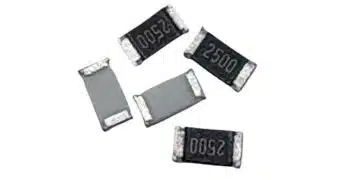This article provides quick overview on new circuit protection technologies that have evolved in the last few years. Written by Pat Denton, published by TTI Market Eye.
The Hybrid MOV-GDT
Metal oxide varistors (MOVs) are a ceramic protection device that have been around for years. Gas discharge tubes (GDT) have also been around for a while. One of the drawbacks of the MOV is that it wears out over time because it is constantly biased in the circuit. New design innovations have created significant miniaturization of GDTs in low-profile packages. These packages have allowed engineers to marry the GDT and MOV together into one device. The GDT isolates the MOV from the circuit bias, thus extending the life of the MOV and making the overall end product longer lasting.
Extremely Low Capacitance Diodes
Semiconductor devices inherently exhibit capacitance which can be detrimental to high-speed data signals. As data lines moved from dial-up modems to much faster protocols, protection diodes were initially ignored because their relatively high capacitance degraded signal integrity. Advances in semiconductor chip design allowed manufacturers to shrink the chips or die while maintaining surge capability, which lowered the capacitance. Additionally, manufacturers found that if they put two die in series in the same package, capacitance would effectively be halved. Combining the two techniques allowed designers to lower capacitance of diodes and diode array to acceptable levels for high-speed data line protection.
High-Speed MOSFET-Based Protection Devices
While MOSFETs are not typically used for circuit protection, silicon design engineers have discovered ways to do just that. Modern day ICs with millions of tiny internal circuits are extremely susceptible to variances in voltage levels which can damage the device. New devices based on MOSFET technology operate in nanoseconds and redirect any over-voltage or overcurrent events away from the IC. Additionally, the turn-on window of the devices is much more precise than other technologies, affording superior protection of sensitive ICs.
eFuses
Wire-in-air fuses have been around since the 1800s. With advances in design and production techniques, fuses are still a staple of protection in electronic design. Unlike conventional fuses, the silicon-based eFuse IC has a high-speed current interruption function that turns the circuit off when excessive current flows. In addition, the eFuse is resettable and is not destroyed by a single overcurrent event. It can also incorporate various protection functions such as overvoltage protection.
High-Speed Fuses and Electric Vehicle Fuses
Because these fuses protect power semiconductors, they are sometimes referred to as semiconductor fuses. High-speed fuses provide protection for semiconductor devices such as diodes, SCRs and IGBTs as well as providing protection in harsh DC traction applications. High-speed fuses are available as high as 4,000Vdc and 10,000A. High-speed fuses don’t have intentional time-delay features that other fuses may exhibit. Typical equipment using power semiconductor devices includes inverters, rectifiers, electric vehicle battery management systems, locomotive traction drives, industrial motor drives, battery chargers and more. Electric vehicle high-speed fuses can provide circuit protection solutions for battery and drive inverter protection as well as DC charging and short-circuit back-up protection.
These are just a few innovations introduced over the last few years. Both necessity and brilliant minds will continue to add to new circuit protection products in the future.
Featured image: EV Fuses; source: Bourns
































